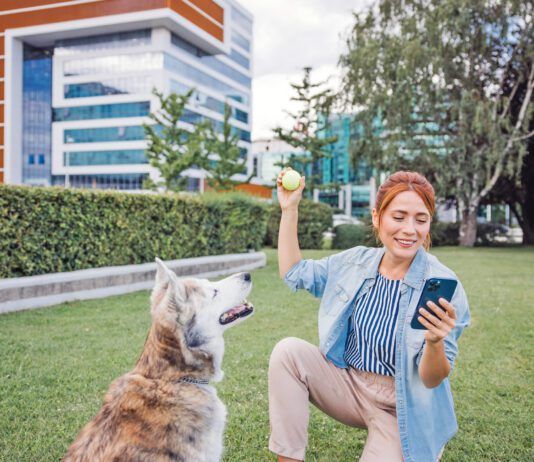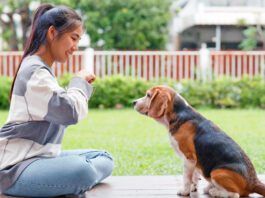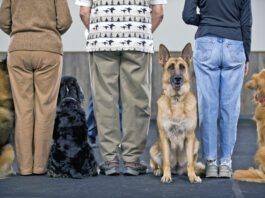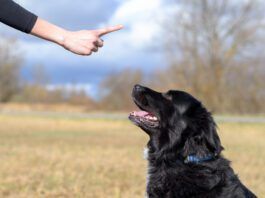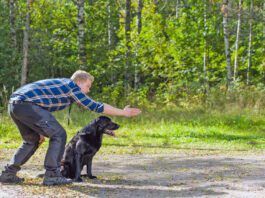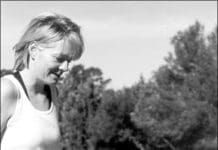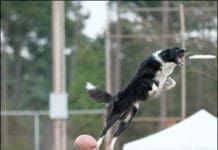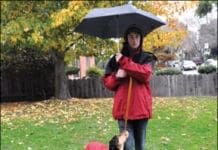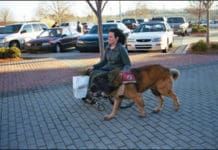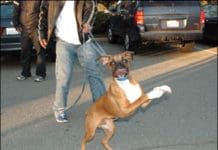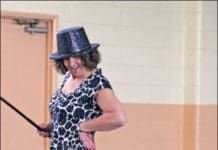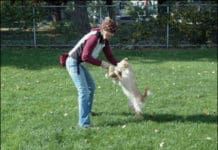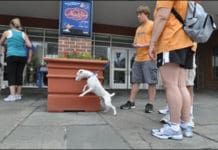Training Small Dog Breeds
There’s a reality show that airs on TLC called Little People, Big World that chronicles the daily lives of the Roloffs, an Oregon family made up of both small (both parents are under 4 feet tall) and average-sized people. The series tastefully portrays how every day activities and seemingly uneventful situations can affect the family members differently based on their size and how society views them. Most importantly, it successfully shows that size does matter, particularly in a society built for the average-sized person. I just wish there was a show, or at least an effective way to get that point across regarding small dogs. They and their owners have long been misjudged and misunderstood.
Canine Water Sports for Aquatic Service Dogs
The curly brown dog stamped his feet and stared at his handler. He had retrieved the plastic dummy countless times. Now what? Something as simple as that look is all it took to start Kathryn Monroe of Mahtomedi, Minnesota, on a quest. It would ultimately take her across the country in search of the knowledge and skills to train her Portuguese Water Dog, Gaucho, to do what his breeding dictated. Work. Water work, specifically. Like many people, Monroe had gotten involved with a breed because she was looking for a dog with an affinity for something she loved. Monroe is a boater. When asked if she had water sports in mind when she chose a PWD, she said, Water sports? I hate water sports! I don't swim
Canine Sports: Herding Competitions
Fetch. Drive. Flank. Come-bye. Go-bye. Way to me. Outruns. Flight zones. Pressure point. That'll do! The sport of herding has a unique vocabulary that distinguishes it from all the other canine sports. In addition to basic obedience cues such as sit, down, stay, and come, dogs are trained to respond to cues that tell them when to start moving livestock, in which direction to move them, when to stop moving them, when and how to move them into pens, and how to use their physical presence to pressure the stock to move but not to scare them into running or stampeding. There is dirt, there is dust, there is livestock that can break bones and bruise a body, and there is livestock poop. And herding teams love it all.
Disc Dog Competitions
The cattle dog-mix races across the turf, his claws digging into the ground, pushing hard into his next stride, building momentum, faster, faster, faster. With a final turbo blast powered by his rear legs, he pushes off the ground and vaults into the air, seemingly weightless as he stretches his neck into the sky. A sudden twist of shoulders propels his torso and hips 180 degrees as he changes direction midair and snatches the prize from the air - a simple, round plastic disc. Eyes alight with the thrill of the chase and the kill (catch), he lands nimbly and races back to his handler. Can we do it again? Can we, can we? Yeah, we can. This is the sport of disc dog. It's been around since Frisbees became popular in the early 1970s and the players' dogs chased the players' errant tosses. When a bad toss resulted in a disc rolling on its side, that was fine by Fido.
Agility Sports That are Perfect for the Action Junkie in Your Canine
Agility is probably the most popular and best known of all the sports for canine athletes. It's easy to see why. Your dog gets to do what dogs like to do: move around, jump, run, climb on things, and play! Agility is a high-speed sport in which the handler directs her dog through an obstacle course of jumps, tunnels, weave poles, teeter-totter, and other obstacles. The goal is for the dog to complete the course without exceeding the standard course time" and without incurring any "faults." Faults include knocking jump bars
House Training a Dog in Cold Weather
Nasty, cold, blowing, snowing, sleeting, rainy day out and your dog won't go out to potty? I can relate; I don't much like to go out in bad weather either even if I don't have to poop and pee out there.Help is on the way. Here are five things you can do to help improve your dog's winter eliminate outside" outlook... Go out with her. She may be much more willing to brave the elements if her beloved human is with her. If you go with her you can keep her mind on her business
Dog Carting and Draft Training
What do you envision when someone says “draft work“? What probably comes to mind are horses, mules, oxen, and other large “beasts of burden.” Think again. Since the 18th and 19th centuries, dogs have assisted humans by hauling wagons and carts across fields and through towns. Dogs have delivered milk and mail, hauled the day’s catch of fish from boat to town, and even hauled lumber in lumber camps. This heritage forms the basis upon which the sport of carting was built by a variety of breed clubs. Between the 1970s and 1990s interest in the sport grew; the St. Bernard folks offered their first competition in 1988, and Bernese Mountain Dog fans added theirs in 1991. The natural inclination of dogs to pull has been literally harnessed by a variety of people through the years. Put backward pressure on a leash and collar, and most dogs will pull forward. Take that “opposition reflex” and a nice, padded harness, and you can see where this is going. Forward, of course! Sledding. Weight pulling. Sulky driving. Skijoring. Carting. Some of these activities are still used to help humans with important tasks. Sled dogs have delivered critical medicines in the dead of winter. Service dogs pull wheelchairs. And some dogs show off their carting skills during public demonstrations and therapy dog visits. This sport has a very practical aspect to it. If you are creative, I’m sure there are tasks around home that you can find for your carting dog.
Training Your Dog Not to Jump Up
There’s a common misconception that dogs jump on people to establish dominance. Balderdash! Dogs jump on people because there’s something about jumping that is reinforcing for the dog - usually the human attention that results from the jumping. If you want your dog to stop jumping on people, you have to be sure he doesn’t get reinforced for it. Here are five things to do when your dog jumps on people. Of course you need to practice polite greetings in the absence of the exciting stimulus of guests and strangers by reinforcing your dog’s appropriate greeting with you and other family members. Be sure to take advantage of the presence of guests and strangers to reinforce your dog’s polite greeting behaviors while you’re managing with leashes and tethers.
Dogs Riding Safely and Calmly in Cars
Contrary to the advice I offer to clients and WDJ readers, I admit that I'm sometimes careless about taking my dogs in the car with me. I don't always use crates and seatbelts on short trips to town, although I always do on longer travels. Just recently, however, my husband and I loaded up all five of our dogs for their annual well-pet visit to a veterinarian, and I did take the precaution of crating everyone rather than risk canine chaos on the highway. Other than Bonnie's panting, it was an experience in car-ride serenity, and I vowed to crate everyone, always, on future rides. Granted, my dogs aren't the worst in the car. They don't sit in my lap, leap over seats, get into fights, hang out the windows, do laps around the back of the van, or bark at everything outside the car. Other than Bonnie, who pants a lot and sometimes Even so, they're safer in crates. Loose, they are a distraction, which decreases my driving safety. Not as bad as texting, but still!
Dancing With Dogs
Snapping fingers and tapping feet are the signature moves of musical freestyle – and that’s the audience! What happens between dog and handler during a musical freestyle performance is simply magical. The handler gives subtle cues, and her dog executes complicated maneuvers, one after the other, as the pair moves across the floor, their routine choreographed to music that emphasizes their connection. For those of you whose introduction to this sport was watching a widely distributed video clip of Carolyn Scott’s routine to “Grease” with her Golden Retriever, Rookie, you were probably awestruck. You may have even gotten a little misty eyed, recognizing the commitment, training, and connection between two different species. But it was the look on Rookie’s face that sold you that this was a sport worth exploring. This dog was having a blast, and the behaviors he was doing were difficult! How could training something so hard be so fun?
Best Dog Training Treats for Different Training Scenarios
Experiment with a wide variety of foods to find out what treats your dog loves most. If higher-value treats don't work, remove your dog to a less distracting environment, gradually increasing distractions as he's ready to handle them.
How to Train Your Dog to Calmly Walk on Leash
Passing by all manner of things in the real world - and being passed by them - is an important canine good manners skill. Unfortunately, it seems to be one that is absent in many dogs’ behavior repertoires. Some training classes don’t address this behavior challenge at all. Others do, but owners don’t always take time to generalize the behavior outside the training center. Their dogs, in the real world, still bounce over to greet any and all comers on the street, or on the opposite end of the continuum, shy away from people and things that frighten them. My “Downtown Hound” class graduated in early September with a celebration at Nutter’s Ice Cream in nearby Sharpsburg. It was a 90 degree-plus day with high humidity, and the ice cream parlor was a popular spot in this small Maryland community. I watched with pride as the four dogs lay quietly at their humans’ feet, happily downing the occasional offered dog treat while their owners licked ice cream cones. More importantly, they rested quietly as people walked by with strollers and dogs, kids on skateboards flew past noisily, and motorcycles, trucks, and cars rumbled by a few feet away on busy Main Street.


